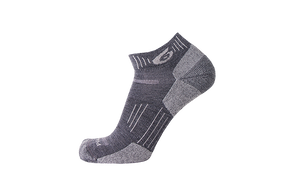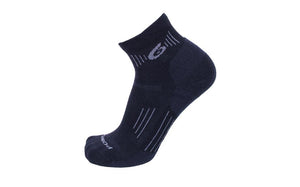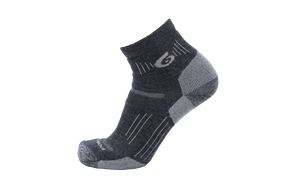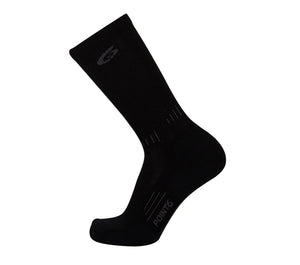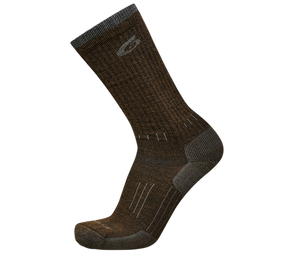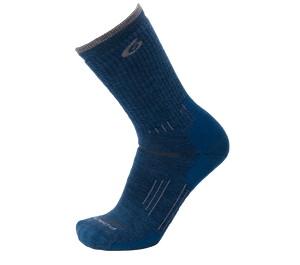
Do you get dizzy spells? Do you have low blood pressure? Do you get fatigued quickly and do you get out of breath with simple physical activities?
If you're answering yes to any of the above, compression socks might be a game-changer for you.
What are compression socks? These socks are medical garments, and your doctor may have advised you to pick some up if you have a diagnosed health condition. .
Keep reading to learn more about who might need compression socks, where to buy them, and what they can do for you.
Compression Socks and Blood Flow Promotion
The primary purpose of a compression sock is to promote blood flow and circulation.
They come in various lengths and are usually longer than your typical sock, and may hit over the calf.
They will have an additional elastic that will compress your leg, promoting blood flow to and away from the lower leg and foot.
Blood Pooling
People with dysautonomia and other venous disorders might have a problem with blood pooling. This is a problem with the systemic blood circulation system. Blood pooling occurs when your body has trouble returning blood to your heart after it distributes to your body's various tissues, muscles, and organs.
Compression socks target the legs, which are more vulnerable to blood pooling since they are further from the heart and your body has to work against gravity to get blood from the bottom to the top half of your body. In someone without disordered blood circulation, oxygen-rich blood is dropped off to your legs, and oxygen-poor blood is transported through your veins back to your heart.
A chronic venous insufficiency indicates that for some reason, the veins in your legs cannot bring the blood back to your heart.
Veins in your legs have valves that ensure blood returns to the heart's right atrium, but if you suffer from blood pooling, it's likely the valves do not work as well. This can cause the blood to actually flow backward, and the phenomenon is what the medical community calls "blood pooling."
This is not ideal because the blood that collects is poor in nutrients and oxygen, and will contain higher levels of waste and carbon dioxide.
Symptoms of Blood Pooling
USA Vein Clinics lists some of the symptoms associated with blood pooling.
- Changes in skin appearance
- Varicose veins
- Cramps
- Swelling
- Fatigue
Vulnerability to Blood Pooling
In this section, we'll address why some people might be vulnerable to blood pooling.
Chronic venous insufficiency is associated with conditions such as:
- Being overweight
- Pregnancy
- POTS
- Diabetes
- Genetic factors
- Blood clots in legs
- A sedentary lifestyle, leading to increased blood pressure in the leg veins over time
- Lack of exercise
- Deep vein thrombosis
Patients that wish to ameliorate symptoms may find benefit from eating a healthy diet and getting sufficient exercise.
However, developing chronic blood pooling is often linked to one's genetics and venous disorders can occur in otherwise healthy individuals.
If you suffer from blood pooling in the legs or abdomen, it may be helpful to prop your legs up against a wall now and then. Sit cross-legged in chairs, and consider wearing compression socks.
How Compression Socks Help Improve Leg Circulation
These devices improve blood flow and circulation by exerting pressure on the veins and tissues in your feet and legs.
Compression socks will also help to avoid blood clots, relieve pain and tiredness, and reduce swelling. They should be graded, delivering more force to the foot and lower legs and less force as they progress up the leg.
We measure compression levels in mmHg (millimeters of mercury) units, which represent a certain amount of pressure. Your doctor will be able to advise you on the best compression level for you. Over-the-counter compression stockings will be 15-20 mmHg, while medical class stockings will be 20-50 mmHg.
Should You Wear Compression Socks?
The following are people that may benefit from utilizing compression stockings for better health.
If You Are Pregnant
Due to increased blood volume during pregnancy, certain women are more likely to have leg and ankle edema, poor circulation, and varicose veins.
Women may suffer a variety of discomforts during pregnancy as a result of hormone imbalances and critical changes in their bodies.
Their bodies produce relaxin, a hormone that loosens the ligaments. This helps prepare them for childbirth, but it can also induce side effects including muscle aches and low blood pressure.
Many pregnant women report that leg cramps are typical for their third trimester. In these cases, individuals can benefit from slow stretching, but these exercises may be insufficient treatment.
Compression stockings can lessen the risk of experiencing these symptoms and provide relief from pain.
If You Have a Specific Medical Condition
People with specific medical conditions, such as a family history of venous disorders, recent surgery or injury, or people who are recovering from an extended period of bed rest may benefit from the improved circulation induced by compression stockings.
As Long Covid becomes a worldwide medical emergency, more researchers are looking into conditions like dysautonomia and POTS. Both of these conditions can be treated with compression socks.
Lightheadedness, fainting, low blood pressure, tachycardia, weariness, "brain fog," and muscular soreness caused by blood pooling in the legs can all be reduced or eliminated using medical compression stockings.
They may also increase patients' stamina, allowing them to withstand longer periods of upright exercise before their symptoms appear.
If You Have a Venous Disorder
Compression stockings can provide symptom alleviation and vein support for those suffering from venous ulcers, varicose and spider veins, and varicose and spider veins. This is especially effective when combined with physical therapy or some sort of gentle exercise.
Types of Compression Socks
The following types of compression socks are commonly available.
Commercial versus Medical-Grade
If you experience light symptoms, you may be able to use over-the-counter compression socks. These have a compression level of 15-20mmHg.
If you experience more serious symptoms or are following doctor's orders, you may need medical-grade compression socks.
For example, if you are suffering from dysautonomia, most specialists advise patients to try stockings that are in the 20-40mmHg range.
Height of the Sock
When you're looking for a compression stocking that will actually improve leg circulation, you'll want to look at the sock's height (rise).
Waist-high socks may be suitable for patients with more serious symptoms like blood clots in legs. Their height will also help you compress the abdominal area, where blood also tends to pool (especially with inactivity and bed rest). If you are suffering from serious symptoms, we highly recommend getting a sock that is at least waist-high.
Lower compression levels or stockings that are not at least thigh-high will provide less benefit for patients with serious symptoms.
That being said, if you prefer over the calf or thigh-high socks, you can go for these as well. It's all about comfort.
Even if you do not suffer from a disorder necessitating you to wear medical-grade compression socks, we advise you to look into which height of sock may be better for your specific situation. We want you to discover something comfortable that you will want to wear all the time, while also alleviating your symptoms.
If you decide to shop with us, know that our products come with warranties ensuring you are satisfied.
Open or Closed Toe
Some waist-high medical compression stockings have open or closed toes.
Open toes are ideal for summer footwear, and they may be more comfortable for patients who suffer from sensory neuropathy in their feet.
Other than that, there isn't a noticeable difference between open- and closed-toe fashions.
Sheer or Opaque
Sheer stockings may be a better alternative for individuals who need formal wear options. They can be paired with dresses. That being said, they may rip and tear faster than sturdier stockings.
An opaque sock may feel softer and come in cotton or wool materials. These will be sturdier than sheer compression stockings.
Sock Material
Our collection features compression socks made of merino wool.
We prefer wool over cotton for its quick-drying and temperature-regulating properties. The sturdy nature of wool means with good fabric care, the socks should be lasting consumers a lifetime.
We advocate for socks made of hard-wearing material because our customers often work in demanding fields like construction, and we want them to feel at their best without having to worry about sock wear and tear.
You can expect socks made of merino wool to:
- Support and improve leg circulation
- Support energetic and healthy muscles and thereby physical endurance
- Reduce swelling, pain, and fatigue in the legs
- Enhance recovery from physical exertion
This being said, while we're clearly showing bias for wool compression stockings, you can find suitable stockings in synthetic materials like polyester and nylon as well as the more traditional cotton.
Our socks use a combination of wool, nylon, and spandex. The wool keeps your skin snug and dry, and we've strategically placed nylon in high-wear areas to ensure the maximum longevity of the socks. We use spandex to provide the socks with elasticity.
Note that if you are allergic to latex, you should be looking for latex-free compression socks. This is because many commercially available compression socks use latex in the elastic at the top of the sock.
Why Get Merino Compression Socks
These socks are designed to do it all.
They feature:
- Sport-specific cushioning
- A non-binding welt top (keeps sock nice and tight without cutting off circulation to your leg)
- Arch support and ankle brace
- Merino wool to keep you comfortable in all weather conditions
We specifically like merino wool for compression socks because of its versatility. They will keep your toes warm in cold weather and promote circulation that way, and will also provide breathability if you're in warmer conditions.
They also have a high warmth-to-weight ratio. This means your compression socks will not weigh you down while they regulate your temperature and blood flow.
Because patients will be wearing their compression socks for hours at a time, we want them to experience the most breathable, lightweight material while they get relief from their symptoms.
Cost of Compression Socks
There will be a lot of cost variance in compression socks depending on the material, quality, and construction.
Prices for stockings range from $20 at the drugstore to $150 for high-end prescription variants.
Check with your insurance carrier to see if they cover medical compression stockings with a doctor's prescription.
If not, you may acquire them online, but make sure to pay attention to any reviews possible for clues as to how the socks will fit.When it comes to compression socks, we find that the inexpensive drugstore options usually are not made to last and have weaker compression. Customers may be better off investing in a pricier sock in return for longevity and functionality.
What Are Compression Socks?
Compression socks are a commercially-available but often medically-recommended device to promote blood circulation in the legs.
They are ideal for pregnant women or patients suffering from vein disorders. If you are experiencing swelling, pain, or fatigue in the leg area you may be able to benefit from long-term wear of compression socks. Patients with more serious vein disorders (e.g. blood clots in their legs) may benefit from socks with a higher compression pressure of at least 20mmHg.
These socks come in various materials and weights, but we recommend socks that clear the knee and are made of breathable warm materials like our own merino wool.
If you're still asking: what are compression socks and will they work for me? All we can do is recommend you try a pair and see if you experience symptom relief!
If you have questions about our inventory and what we carry, feel free to contact us.








